How to improve email deliverability in 2025
Published on May 26, 2025/Last edited on November 11, 2025/15 min read
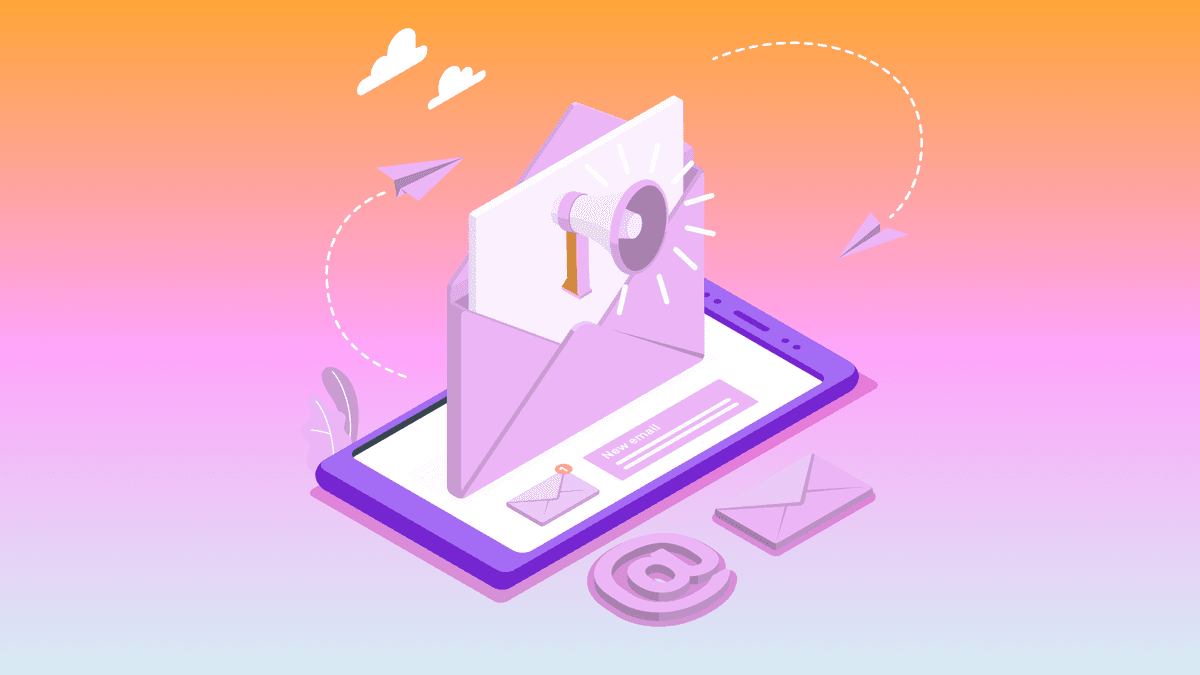

Team Braze
With Gmail and Yahoo’s 2024 changes now fully in effect, the pressure to improve email deliverability is higher than ever.
New rules around authentication, spam complaints and unsubscribe handling have forced brands to reassess consent, list hygiene and reputation.
In this guide, we’ll unpack the latest rules, highlight best practices for 2025 and show how Braze supports smarter, more strategic sending.
What is email deliverability?
Email deliverability is your ability to reach the inbox, not spam or junk folders.
Mailbox providers use signals like opt-in method and user engagement to decide where your email goes.
Why email deliverability affects every campaign metric
When emails miss the inbox, opens, clicks and conversions all take a hit. Improving email deliverability gives your campaigns room to perform—while poor placement holds them back. With mailbox providers prioritizing engagement, deliverability needs to be front and center.
Email remains arguably the most impactful customer messaging channel out there—but only if you’re able to get the messages you send to your customers. In this video, the Braze Email Deliverability team will explore the ins-and-outs of modern email deliverability, how it’s shifted in recent years, and what a successful deliverability program looks like today.
What marketers need to know about the 2024 Gmail and Yahoo changes
In 2024, Gmail and Yahoo rolled out new deliverability rules—focused on authentication, spam complaints, and unsubscribe functionality. While aimed at high-volume senders, these standards now apply broadly, raising the bar for everyone.
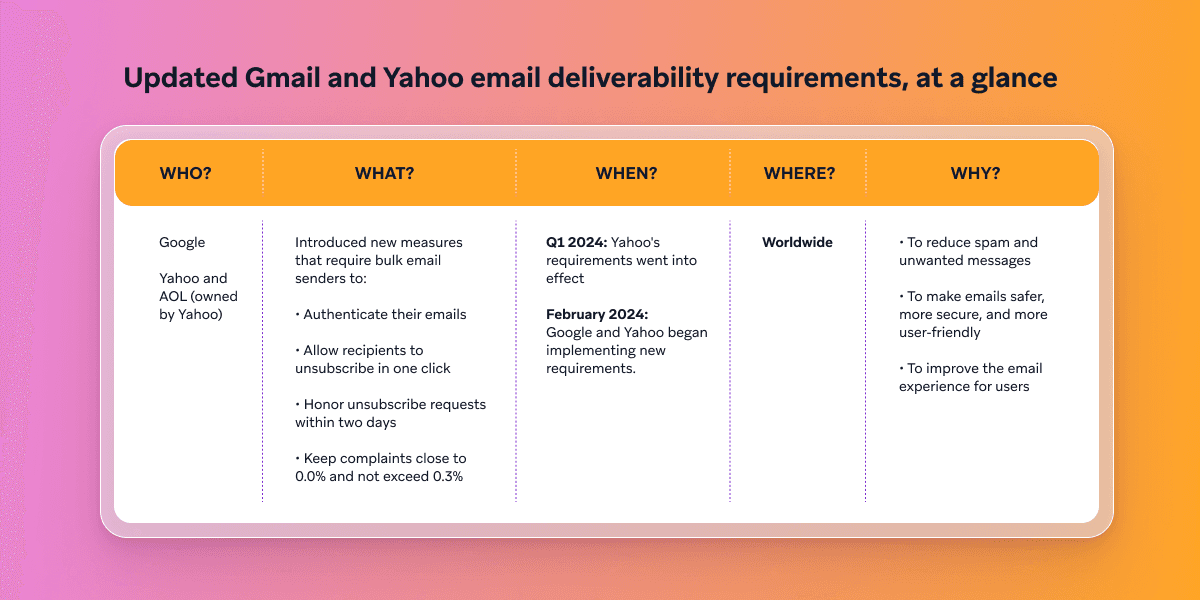
At a glance, the updates focus on three main areas: Authentication, spam complaints, and unsubscribe functionality.
The goal behind the new requirements
Gmail and Yahoo receive billions of emails every day and a large chunk of them are unwanted. These new policies are designed to cut down on inbox clutter, increase transparency, and make it easier for users to control what they receive.
Rather than blocking all bulk* mail, the goal is to reward senders who follow responsible practices and push out those who don’t.
*Google defines bulk senders as any company or user who sends thousands of messages a day to Gmail recipients.
Key policy shifts for bulk senders
If you send more than 5,000 messages per day to Gmail or Yahoo addresses, here’s what’s now expected:
Email authentication
Domain-level email authentication using SPF, DKIM, and DMARC is mandatory. There are several types of email authentication, including sender policy framework (SPF), domain keys identified mail (DKIM), and domain-based message authentication, reporting, and conformance (DMARC).
Google’s authentication requirements for 2024 state that bulk senders should “strongly authenticate” their emails with SPF or DKIM and DMARC to prevent spoofing and to avoid having the emails they send marked as spam. (See Google FAQs here.)
Yahoo’s authentication requirements for 2024 state that senders should “implement stronger email authentication” by using the following industry standard methods of authentication: SPF or DKIM and DMARC. (See Yahoo FAQs here.)
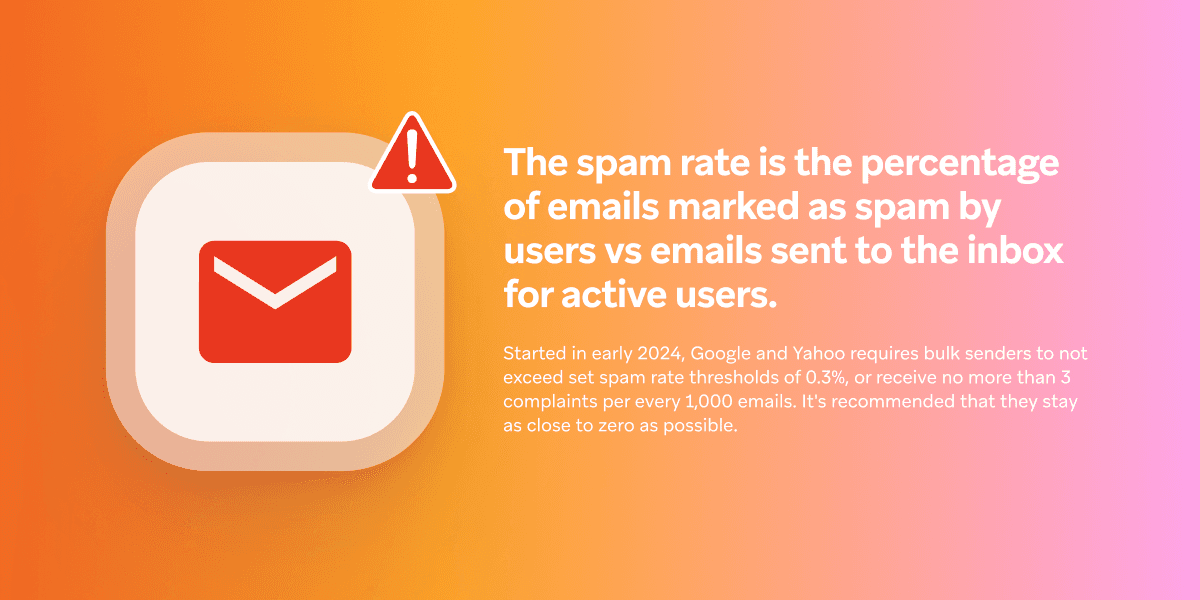
Spam complaint rates
Gmail and Yahoo now enforce a maximum spam rate of 0.3%, with Gmail recommending brands stay below 0.10%. Even lower complaint rates can trigger inbox filtering if other risk signals are present.
One-click unsubscribe
One-click unsubscribe is also required using the list-unsubscribe header and RFC 8058, with opt-out requests processed within two days.
Braze supports and is compliant with both standards. To learn more, see our documentation.
What to expect next
These changes signal a broader shift. Looking ahead across 2025, expect more focus on authentication, security, and AI. Staying proactive and sending relevant, wanted messages will be key.
Why are email deliverability and email list hygiene important?
Email is an incredibly powerful channel for connecting and building relationships with customers, boasting a 38:1 ROI by some estimates. That said, just as it’s next to impossible to get someone to open their door without successfully knocking or ringing their doorbell first, it’s hard to successfully reach users’ inboxes without following email deliverability best practices, which are key to generating positive email engagement that fosters a strong sender reputation. The stronger your sender reputation, the higher the likelihood that your emails will reach your intended audience.
Recipient engagement is the primary driver in mailbox providers' assessments of sender reputation. Too many complaints and a lack of positive engagement will lead to emails being blocked or delivered to users’ spam folders. Opens, clicks, replies, forwards, and moving mail from the spam folder to the inbox are all indications that mail is both wanted and expected by recipients, contributing to the likelihood of inbox placement in the future.
Keeping a healthy email list has long been an important tactic. Brands that target unengaged audiences (a classic benchmark is any email address where the recipient hasn’t opened or clicked over the last six months) run the risk of having their emails blocked or sent straight to junk.
The Braze Email Deliverability team recommends analyzing your email program to find the sweet spot that’s ideal for your engagement strategy. “Each sender is going to have a unique customer base and find distinct insights when they dig into their email data,” said Kelly Hogan, Senior Director, Global Email Deliverability and Compliance, Braze. “But our general rule of thumb is that organizations should make a point of setting up email validation, implementing a double opt-in at sign-up and automatically sunsetting any user who hasn’t opened up one of their emails in the past six months. These are the practices that will lead to positive deliverability outcomes, no matter the industry or vertical.”
The latest changes from Gmail and Yahoo build upon these and other existing standards to improve email deliverability and email list hygiene. It’s important for brands to understand and adhere to these standards in order to be able to reach and engage their intended audience.
Four steps to protect your deliverability in 2025
The best way to stay ahead of these mandates from Google and Yahoo is to implement any changes necessary for complying with their new rules and make sure you keep on top of them.
The following four steps are what both email services expect of bulk senders moving forward.
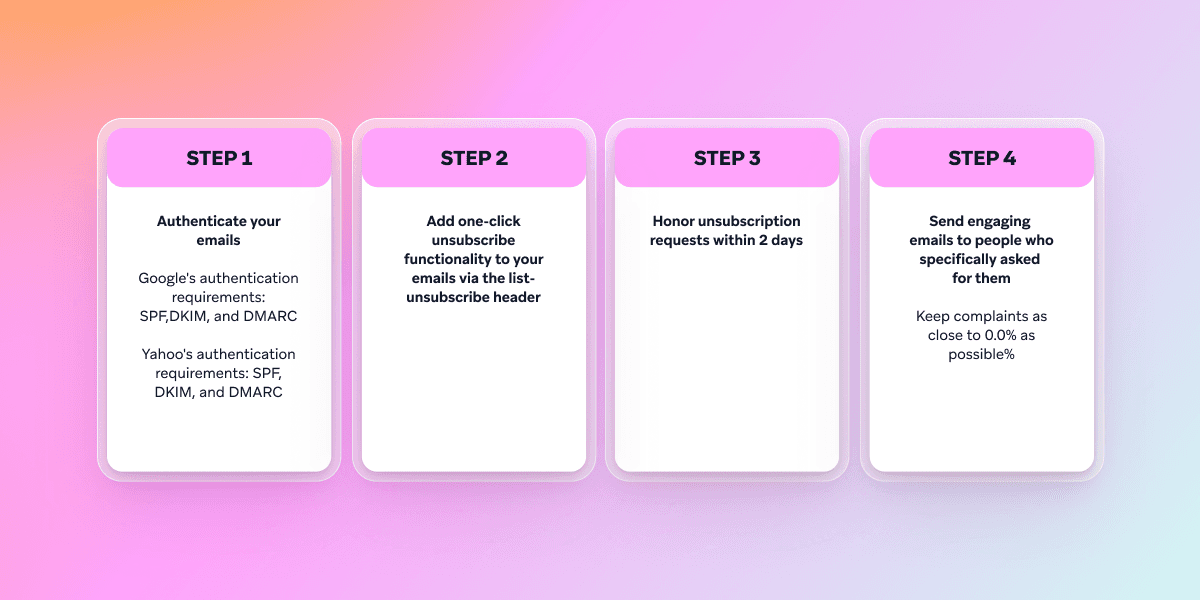
Technical foundations for better deliverability
Deliverability starts with authentication. Gmail and Yahoo now require SPF, DKIM, and DMARC to verify senders and prevent spoofing.
These protocols help prove your messages are legitimate—and without them, inbox placement is an uphill battle.
Set up feedback loops and monitor blocklists
Feedback loops and blocklist monitoring help you catch issues early. With Braze, spam complaint data is managed automatically, while blocklist checks can alert you to bigger deliverability risks.
Regularly review complaint rates, email bounce trends and domain reputation to stay ahead of problems.
Manage IP reputation and warm-up properly
Sudden spikes in volume from a new or cold IP can trigger filters. If you’re switching platforms or using a new domain, warm up gradually—starting with engaged users and increasing volume over time.
A stable sending reputation helps your messages reach the inbox, even at scale.
Braze takes care of the technical heavy lifting
With over a decade of email innovation, an award-winning team of service providers and more than half our customers relying on Braze for email, we combine proven infrastructure with expert guidance to help you scale with confidence and get the most out of our customer engagement platform. Our team can conduct historical email deliverability audits, provide ongoing email deliverability reporting and create tailored IP warming plans, so your messages are set up for success from day one.
Download our guide to uncover ways to enhance email deliverability, how to build and grow your email list the right way, and what metrics to pay attention to.
Email deliverability best practices
Inbox placement is a result of consistently good habits. From how you collect email addresses to how often you send, every choice you make influences your sender reputation. Braze is designed to help email marketers at any level—from lean teams to enterprise operations—adopt these habits with less manual work and more built-in support.
Here are four key ways to keep your deliverability high and stay on the right side of Gmail, Yahoo, and your audience.
Use double opt-in and secure data collection
Double opt-in helps confirm subscribers actually want your emails—reducing the risk of fake sign-ups, typos, and spam traps.
Combine this with secure, bot-resistant forms to build a cleaner, more engaged list from day one.
Maintain continuous list hygiene
Clean your list regularly by removing invalid or bouncing addresses and sunsetting inactive users.
Monitor bounce rates and complaint trends to spot issues early—and run re-engagement campaigns before suppressing cold contacts.
Mailbox providers track how your audience responds. If large portions stop opening, clicking, or engaging altogether, inbox placement can quickly suffer.
Avoid risky list sources (purchased or rented lists)
Buying or renting email lists is one of the fastest ways to damage your sender reputation.
These lists often contain outdated or scraped data—including spam traps—and recipients haven’t consented to hear from you.
Send with consistency—frequency and volume matter
Stick to a consistent pattern. Sudden spikes, long gaps, or sending to your full list at once can all hurt deliverability.
Use engagement signals to guide send timing and avoid email fatigue.
Craft messages that won’t trigger spam filters
void all caps, misleading subject lines and excessive punctuation. Keep a balanced image-to-text ratio and add alt text.
Using Braze Inbox Vision, you can test your emails to predict whether your email will land in spam folders or your customers’ inboxes.
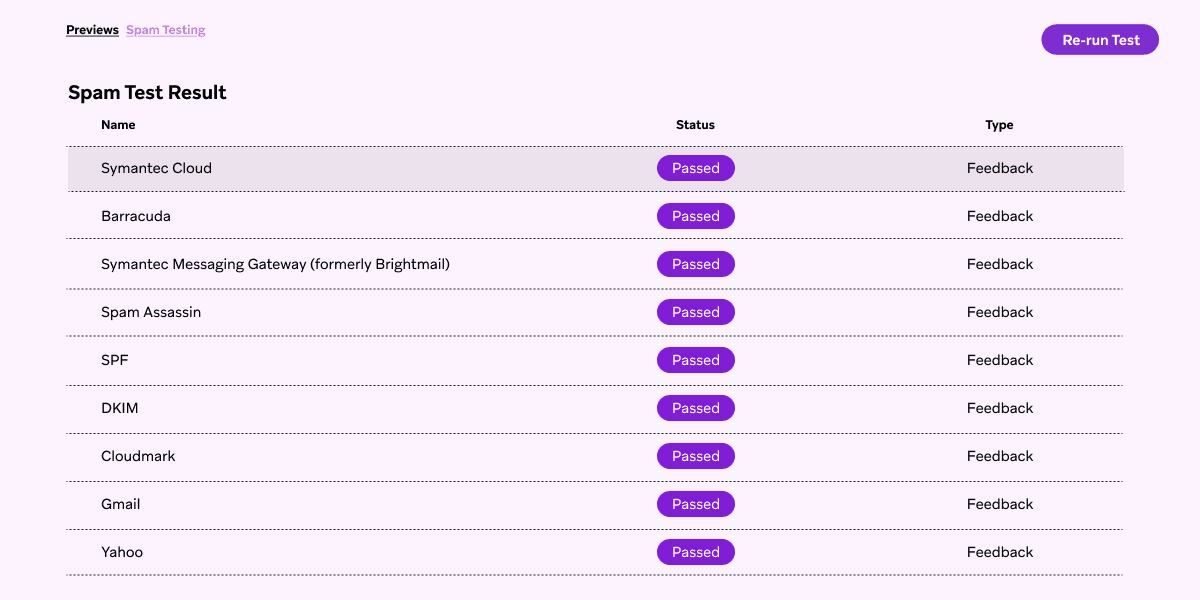
Monitor and act on engagement metrics
Providers track how users respond to your emails—opens, clicks, replies and even deletions.
Low engagement can hurt future inbox placement, so use A/B testing and performance data to fine-tune every send.
Braze users can dig into campaign performance and audience behavior through deliverability indicators like email opens and spam complaints.
Implement sunset policies and re-engagement flows
Set rules to reduce or stop emails to inactive users. Start with re-engagement flows, then suppress contacts who don’t respond.
A lean, engaged list strengthens sender reputation and reduces the risk of spam traps.
Watch for signs of trouble: High bounces, complaints, or trap hits
Spikes in bounce rates or complaints are early signs of trouble.
Monitor bounce trends, feedback loops and potential spam trap issues. Braze’s Deliverability Services team can help identify and address risks.
The silent threat of spam traps
Spam traps are email addresses used by mailbox providers to catch senders with poor list hygiene. They’re not tied to real users and never opted in—so sending to them signals a problem.
Even legitimate brands can hit traps if list validation and cleaning fall through the cracks.
The main types of spam trap to watch out for
- Pristine traps: Never real, never opted in. Often picked up through scraping or fake sign-ups.
- Recycled traps: Once active, now abandoned and repurposed by providers.
- Typo traps: Common misspellings (like “gnail.com”) that can slip in without validation.
How to reduce the risk of being caught in a spam trap
To reduce trap risk, use double opt-in, validate addresses on sign-up, regularly suppress inactive users and avoid purchased lists. If deliverability dips, review your list sources and engagement filters.
Pristine traps | Recycled traps | Typo traps |
|---|---|---|
Never belonged to a real person. Often entered via scraping or fake sign-ups. | Once valid, now dormant. Missed by brands with poor list hygiene. | Misspelled domains or addresses (e.g., @gnail.com). Easy to catch with validation. |
Common email deliverability pitfalls and how to avoid them
Sometimes it’s not a technical error or a spam trap that’s causing deliverability issues—it’s the everyday habits that quietly chip away at sender reputation. These are the most common slip-ups we see and how to course-correct.
Unverified sign-ups and typo errors
Fake or mistyped email addresses can slip in without proper validation. Use form verification and double opt-in to confirm accuracy at the point of entry.
Stale lists and unengaged audiences
Sending to cold contacts damages sender reputation. Suppress unengaged users, segment by activity and focus on those still opening and clicking.
Deliverability dips from poor segmentation or sudden spikes
One-off sends to your full list or sudden volume spikes can lead to blocks and complaints. Ramp up gradually and segment based on recent engagement.
Real brands, real deliverability wins
Deliverability is something smart brands are actively improving every day. Here’s how three Braze customers strengthened their sender reputation, boosted inbox placement and reached more of the right people.
Inbox interest: Taxfix boosts returns with smarter sends
Taxfix is a tax platform that simplifies filing for users in Germany, Italy and France. Through an intuitive app and web interface, it guides people through the process in around 22 minutes—only asking the questions that apply to their unique situation.
The problem
As Taxfix expanded into new markets, they needed a smarter CRM strategy and a platform that could scale with them. Their goals: automate more, personalize deeper, activate new users and reduce churn. That’s when they turned to Braze.
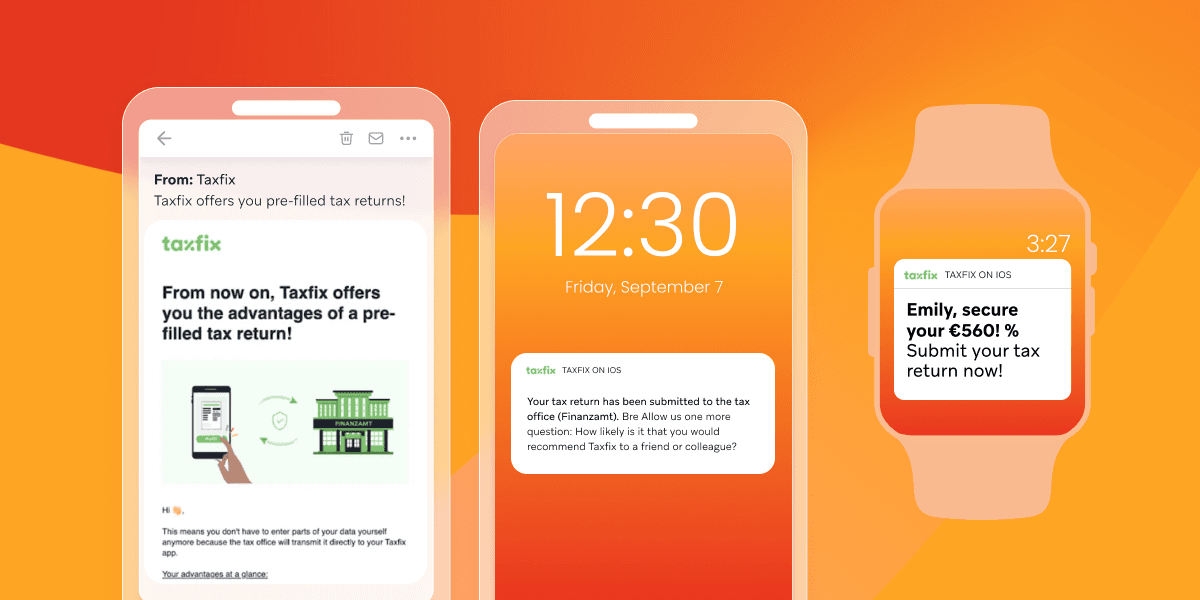
The solution
After switching to Braze, Taxfix connected their iOS, Android and Web apps using the Braze SDKs, tested cross-platform push and in-app messages and verified key user attributes were flowing correctly. They integrated Segment, a Braze Alloys partner, to unify customer data and route it across their stack—streaming data via Braze Currents to Snowflake and Looker for real-time insights and better decision-making.
With Liquid personalization and Content Blocks, they scaled tailored messaging across campaigns—reducing manual workload and giving a lean team the tools to operate like a much larger one.
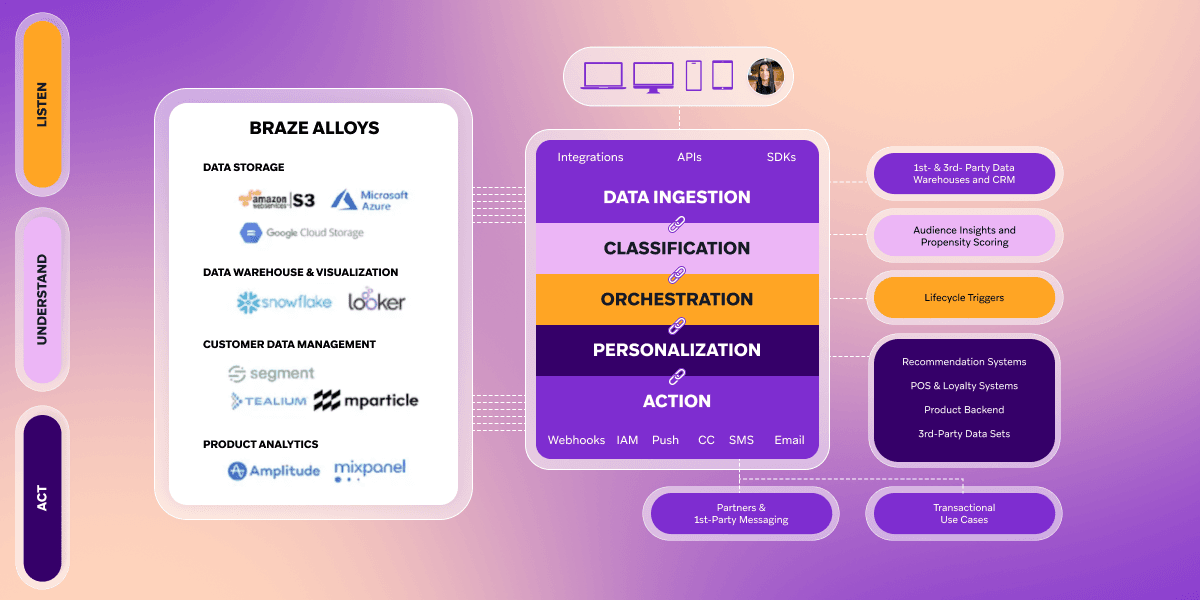
The results
Since adopting Braze, Taxfix has seen a 15% increase in tax return submissions and a 25% lift in product feature upsells—compared to users not receiving CRM campaigns. Deliverability surged to 99.8%, up from previous averages of 60–70%.
With data and campaign tools unified in Braze, the data team cut analysis time by up to 70%, while the CRM team reduced campaign build time by nearly half—freeing both to focus on strategy and customer experience.
Happn: Improving engagement and sender reputation
Happn brings a little serendipity back to dating. Instead of endless swipes, the app connects users with people they’ve actually crossed paths with—offering a second chance at missed connections. It’s a refreshing take in a crowded space and 85 million users are on board.
The problem
To spark more real-world connections, Happn turned to Braze to build smarter, cross-channel engagement. Their first hurdle? Improving email deliverability. Since many users sign up via Facebook—often linked to outdated or invalid addresses—Happn saw high bounce rates and low opens.
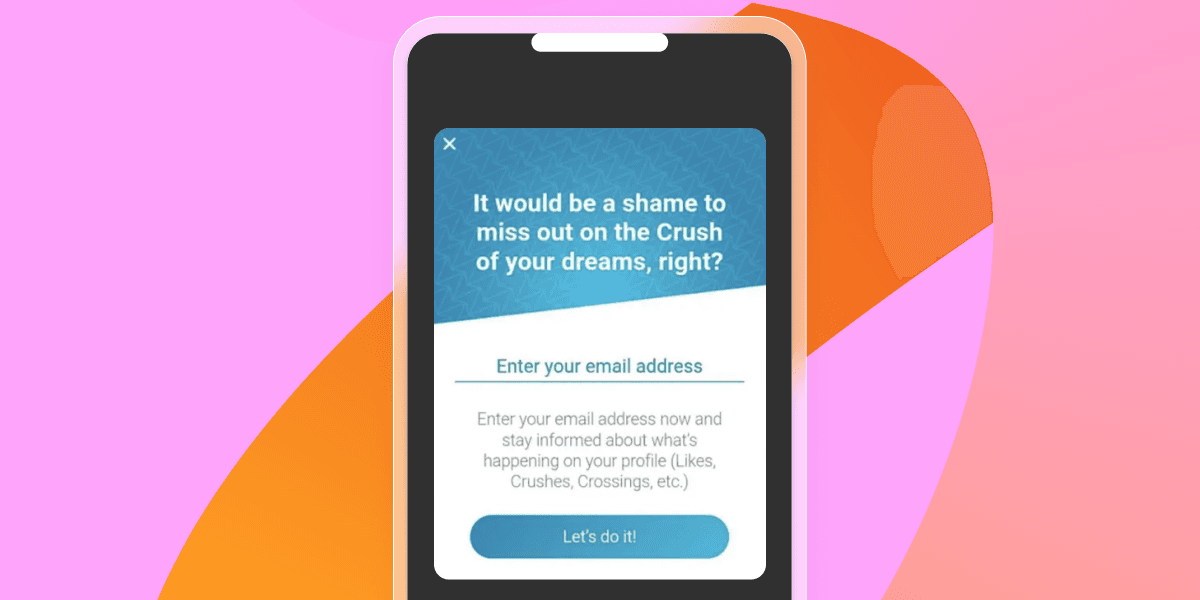
The solution
To fix this problem, they used Braze to add a targeted in-app message during onboarding, prompting users to provide a valid email. Simple, effective and the first step toward a stronger cross-channel experience.
New users receive a confirmation email, a welcome message and an onboarding email with step-by-step guidance—creating a smooth, informative flow that builds trust and strengthens the connection from day one.
The results
The impact was immediate: 50% of new users shared valid email addresses at sign-up, open rates improved and bounce rates dropped by 42%.
Canva: Smarter segmentation for better inbox placement
Canva is a free online design tool that lets anyone create social posts, presentations, videos, posters, logos and more—no design experience required.
The problem
To support their global design community during COVID-19, Canva needed a fast, effective way to deliver relevant, interest-based content to millions of users worldwide.
The solution
Canva scaled email sends from 30 to 50 million per week using a strategic IP warm-up approach—preserving 99% deliverability by increasing volume gradually and focusing on high-performing campaigns. To support users across 20 languages, they also revamped their localization strategy using Connected Content and the Google Sheets API, automating translations and saving days of manual work. They gained a faster turnaround, more relevant messaging and strong engagement across global markets.
The results
Canva’s thoughtful, user-first approach paid off—with a 33% increase in open rates, a 2.5% lift in engagement and 99% deliverability maintained even as weekly email volume jumped from 30 million to 50 million.
How is Braze supporting stronger deliverability?
With more than 100 years of combined experience in the areas of deliverability and email strategy, the Braze Email Deliverability team enables best-in-class email marketing, empowering marketers to achieve success with all aspects of this potent channel, from deliverability to conversions and long-term retention. Here’s an overview of two Braze offerings that support stronger deliverability.
1. The Braze Email Deliverability Center
This self-service tool offers brands insight into their email performance, tracking data on sent emails and the company’s sending domain. Braze users can review their sender reputation by IP address or sending domain, check for authentication and identify delivery errors to uncover and address any issues that might be impacting deliverability.
Email isn’t just one of Braze’s channels—it’s a core part of our platform. With 92% of customers using Braze for email and over 400B emails sent in 2023, we’re built to support email programs at every scale.
2. Braze Deliverability Monitoring and Premium Deliverability Services
Braze offers two professional service options that can help you to achieve your deliverability goals:
- Email Deliverability Monitoring: With Deliverability Monitoring you’ll receive enhanced email onboarding sessions and one-on-one monthly check-ins with a named Braze Deliverability Consultant. This service provides guidance on IP and domain warming, monitoring and reporting on email performance and consultation on deliverability strategy.
- Premium Deliverability Services: With Premium Deliverability Services, you’ll receive higher-touch onboarding and more in-depth ongoing support from a Braze Deliverability Consultant. Your named expert acts as an extension of your company’s email marketing team, offering in-depth insight into your company’s sending reputation and performance and help with strategic email initiatives.
Final Thoughts
The latest deliverability requirements from Gmail and Yahoo raise the bar—but they also create a more level playing field. All senders are now held to clear, consistent standards, which benefits the brands already focused on building respectful, relevant customer relationships.
For marketers committed to clean data, clear consent and thoughtful engagement, this shift is an opportunity. As inboxes become more protected and more intentional, there’s more room for valuable, well-crafted messages to land—and resonate.
With Braze, marketers can stay ahead of evolving inbox rules and build meaningful, measurable connections at scale—without losing time, clarity, or control.
Email Deliverability FAQs
A good email deliverability rate is typically 95% or higher—great programs often see rates above 98%.
You can test email deliverability by monitoring bounce rates, inbox placement and engagement across providers.
Email deliverability is affected by your sender reputation, list quality, authentication, content and engagement metrics.
Spam complaints signal that your emails are unwanted and can quickly damage your sender reputation and inbox placement.
Email deliverability is important because even the best message doesn’t matter if it never reaches your audience.
Related Tags
Be Absolutely Engaging.™
Sign up for regular updates from Braze.
Related Content
View the Blog
The new inbox reality: How iOS changes are reshaping email marketing

Aparna Prasad

Experience optimization: Turning data insights into better journeys

Team Braze

December 2025 Bonfire Marketer of the Month: Jagex’s Emma Oliver
